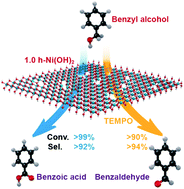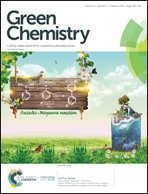Defect engineering of nickel hydroxide nanosheets by Ostwald ripening for enhanced selective electrocatalytic alcohol oxidation†
Abstract
Selective electrocatalytic oxidation (ECO) of alcohols to aldehydes or acids is an environmentally friendly and economical method in modern industries. Herein, tunable holes and vacancies in nickel hydroxide (h-Ni(OH)2) by the Ostwald ripening process are successfully fabricated, and the as-prepared electrocatalysts are used for the selective ECO of alcohols into acids or aldehydes with excellent electrocatalytic activity and stability, where a selectivity above 92% to benzoic acid with a benzyl alcohol conversion of 99% on 1.0 h-Ni(OH)2 was obtained, while a selectivity of >94% to benzaldehyde with a conversion of >90% could also be achieved once the 2,2,6,6-tetramethylpiperidine-N-oxyl (TEMPO) radical was employed. A paired electrolysis system is employed using 1.0 h-Ni(OH)2 and 1.0 PtO2/h-Ni(OH)2 as electrocatalysts at the anode and cathode, respectively, to simultaneously achieve the selective ECO of benzyl alcohol and H2 production, resulting in a high faradaic efficiency of 192.9%. The excellent ECO activity is mainly due to the abundance of holes and vacancies which facilitate the diffusion rate of the reaction species, adjust the electronic structure and surface properties of h-Ni(OH)2, and change the charge density around benzyl alcohol, thereby enhancing the adsorption energy of the alcohol. This study introduces a new avenue for the understanding and future design of advanced defect-based electrocatalysts for electrosynthesis and energy conversion.



 Please wait while we load your content...
Please wait while we load your content...